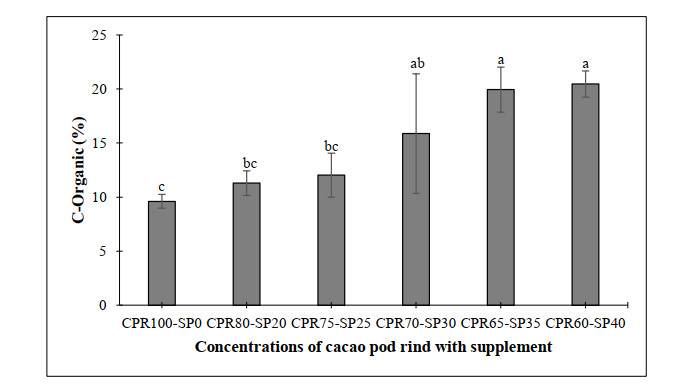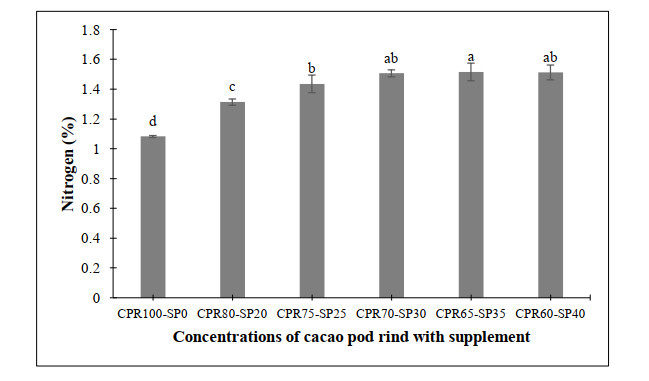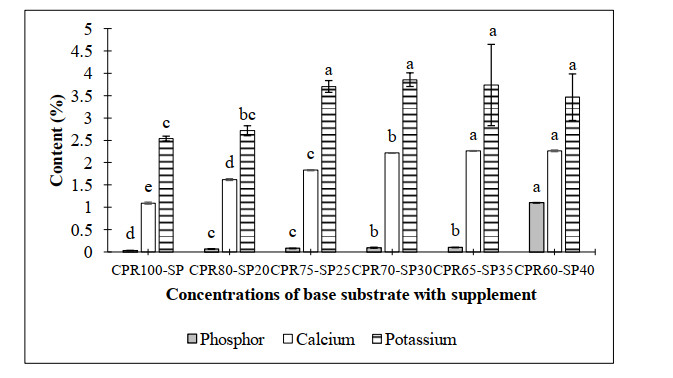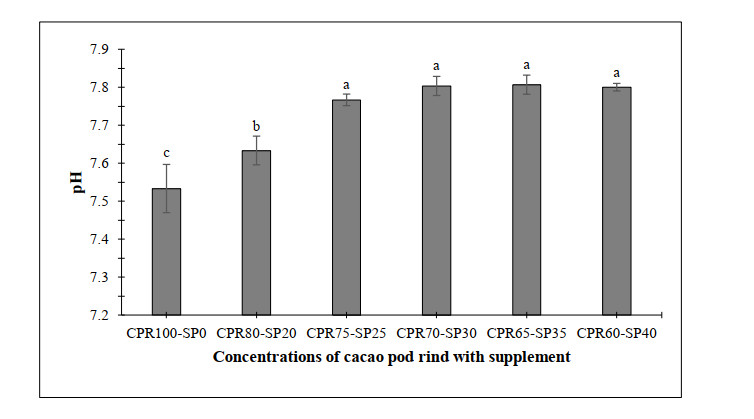Implementation of the utilization of reasonably available biological resources on an ongoing basis is the development of industrial technology and the production of bio-compost pellet-granule organic fertilizer (with an active ingredient of Trichoderma sp.). Microorganisms can be formulated and developed into a land probiotic technology to optimize its role as a decomposer and plant growth promoters. This study was designed of six treatments and three replications. The base substrate consisted of concentration of the cacao pod rind (CPR) with the supplement (SP) cacao leaf waste + chicken manure + goat manure + cow manure with ratio at (1:1:1:1). The experimental treatments were CPR 100% + without SP (CPR100-SP0), CPR 80% + SP 20% (CPR80-SP20), CPR 75% + SP 25% (CPR75-SP25), CPR 70% + SP 30% (CPR70-SP30), CPR 65% + SP 35% (CPR65-SP35) and CPR 60% + SP 40% (CPR60-SP40). The results showed that the process of composting for 28 days with inoculation of Trichoderma sp. can increase C-organic, nitrogen, phosphor, calcium, potassium content and pH of bio-compost. The high C-organic and nitrogen were found at CPR70-SP30, CPR65-SP35 and CPR60-SP40. The phosphor, calcium and potassium content increased with the increasing of the supplement in the bio-compost. The high pH was found at CPR75-SP25, CPR70-SP30, CPR65-SP35 and CPR60-SP40. The data from the pH measurement of the bio-compost ranges from 7.53 to 7.81.
1.
Introduction
The cacao pod rind (CPR) is the result of plantations with poor management [1]. The CPR is immediately thrown as waste, but in fact the cacao rind can still be processed into something useful [2,3,4]. A number of studies on extracting the cacao rind are the production of fodder [5], flour [6], and extract of pectin [7,8,9]. In addition, cacao rind is rich in nutrients and can be used as a plants growing media that can be used as a compost [4]. Waste processing to produce bio-compost is the best alternative solution now. Processing waste into compost will indirectly create a clean environment and overcome pollution [10,11].
Compost is an organic fertilizer made by people from the process of decaying the remains emissions of living things (plants and animals) [12]. The production process of compost or composting is a biological process because during the process, a number of living organisms called microbes, such as bacteria and fungi play an active role [13,14,15]. One alternative effort is the use of microorganisms as decomposers processing organic materials into bio-compost. The one of these microorganisms which potential as a decomposer is Trichoderma sp.
Trichoderma sp. is categorized as decomposer fungi for having the nature of saprophyte, thus the role is providing free organic matter especially in the provision process of compost [16,17]. One of solutions to accelerate organic matter decompositions is by using the fungus Trichoderma sp. Trichoderma sp. will reduce organic matter such as the carbohydrates, especially cellulose with the help of a cellulase enzyme [18]. Trichoderma sp. can produce the cellulase enzyme, selubiose (β-Glucosidase) and chitinase. A cellulase enzyme is an enzyme participates in the process of organic matter decompositions because cellulase enzyme is a multienzyme consisting of cellobiohydrolase, endoglucanase, and β-glucosidase [19,20]. In addition, Trichoderma sp. can also produces chitinase enzyme which plays an important role in the control of pathogenic plants in microparasitism [21,22]. Trichoderma sp. is a soil fungus and a decomposer fungus, which contains the main organic materials, it is saprophyte, thus the role is providing free organic matter especially in the provision process of compost. Trichoderma sp. can also be used as biofungicides, in which Trichoderma sp. has the capability to hinder growth of some fungi causing diseases in plants such as Rigidiforus lignosus, Fusarium oxysporum [23], Rizoctonia solani, Sclerotium rolfsii [24,25].
The use of organic bio-compost on the soil is absolutely necessary not only as a source of plant nutrients but also to increase the soil cation exchange capacity through the resulting humus [26]. The compost materials, including the pod and leaves of cocoa were found in plantation land, which it can be breeding grounds for pests and plant diseases. In addition, manure of various types of livestock were available and has not been used so that it tends to pollute the environment. Therefore, the objective of this work was determined the C-organic, nitrogen, phosphor, calcium, potassium and pH of bio-compost were prepared from base substrate at different concentration of cacao pod rind with supplement (cacao leaf waste + chicken manure + goat manure + cow manure = 1:1:1:1, respectively) by using Trichoderma sp.
2.
Materials and methods
2.1. Materials
The materials used in the study consisted of Trichoderma sp. a local isolate was purchased from the rhizosphere of the cocoa plant as a decomposer. The cocoa pod rind (CPR) and cocoa leaf litter were obtained from cocoa plantation in Sigi Regency. The CPR was dried in the sun the moisture content up to 5%, and then milled to become flour. The chicken manure was obtained from chicken farms, goat manure was purchased from goat farms and cow manure was obtained from cattle farms which were located in Sigi Regency. The chicken, goat and cow manure were dried in the sun the moisture content up to 5%. All the chemicals used for the bio-compost analysis were of analytical grade.
2.2. Research design
This research design with six treatments and three replications. The substrate consisted of a comparison of the base substrate i.e. cacao pod rind (CPR) with the supplement (SP) of consisted were cacao leaf waste + chicken manure + goat manure + cow manure with ratio (1:1:1:1) respectively. The experimental treatments were CPR 100% + without SP (CPR100-SP0), CPR 80% + SP 20% (CPR80-SP20), CPR 75% + SP 25% (CPR75-SP25), CPR 70% + SP 30% (CPR70-SP30), CPR 65% + SP 35% (CPR65-SP35) and CPR 60% + SP 40% (CPR60-SP40).
2.3. Preparation of Trichoderma sp. and bio-compost
Trichoderma sp. was isolated from soil samples from the rhizosphere of the cocoa plant according to the method by [27] with a slight modification. Briefly, the suspension was made with 10-8 dilutions, the growth medium used potato dextrose agar which consisting of 200 g potato + 20 g sucrose + 20 g agar. A pure culture of Trichoderma sp. 10 mL with a spore concentration of 108 CFU/mL was inoculated on the basic ingredients of 100 g rice bran which had been added with 30 mL of distilled water. The mixture of these ingredients was put into the pellet machine (Fomac) for the pellet formation process, then the pellets formed were made granules using a manually shaken cross section to form the pellets as a decomposer inoculum. The composting preparation and process consisted of six treatments, i.e. CPR 10 kg + without SP (CPR100-SP0), CPR 8 kg + SP 2 kg (CPR80-SP20), CPR 7.5 kg + SP 2.5 kg (CPR75-SP25), CPR 7 kg + SP 3 kg (CPR70-SP30), CFR 6.5 kg + SP 3.5 kg (CPR65-SP35) and CPR 6.0 kg + SP 4.0 kg (CPR60-SP40). The treatments were mixed then it has been added with water until the water content was 60%. The sample was put into the composting container, then 100 g of Trichoderma sp. inoculum was inoculated at each treatment. The composting process for 28 days, then the content of N, P, K, Ca and pH were analyzed.
2.4. Parameters measured
C-organic content was determined using the method by [28]. Nitrogen content was determined with kjedahl method and the determination of phosphorus content was carried out by the molybdovanadate method using UV-Vis spectrophotometry. Flame Photometers BWB-XP are used for measuring calsium and kalium and the pH of bio-compost were measured using a pH meter.
2.5. Data analysis
All data were determined in triplicate and it’s were analysed by of one-way analysis of variance (ANOVA) using SPSS version 21, followed by Duncan’s multiple range tests. The statistical significance was defined at p ≤ 0.05.
3.
Results and discussion
3.1. C-organic content
The C-organic bio-compost in various concentrations CPR-SP are shown in Figure 2. The C-organic of bio-compost was significantly different (p ≤ 0.05) from those of the CPR-SP. The highest C-organic was found at CPR60-SP40 (20.45%), however this value did not differ significantly (p > 0.05) from those determined for CPR70-SP30 and CPR65-SP35. The lowest C-organic was found CPR100-SP0 (9.61%) and this value no different from CPR80-SP20 and CPR75-SP25. It was supported by the findings of [29] that the C-organic of the bio-compost from oil palm empty bunches (1 kg) which given Pleurotus ostreatus (8 g) and Trichoderma harzianum (2 g) as decomposer was found 21.63%.
The aspect of C-organic content, the concentrations of CPR70-SP30, CPR65-SP35 and CPR60-SP40 were can be a good choice as a substrate and supplements for the production of granular bio-compost which was more practical for use in agricultural land. A further implication is that the productivity of agricultural land can be increased, especially in the wet tropics by improving the physical, chemical and biological characteristics of the soil [30].
3.2. Nitrogen content
Analysis of nitrogen content in bio-compost in various treatments showed a significant effect on nitrogen content in bio-compost. The average nitrogen contents in bio-compost are presented in Figure 2. The highest nitrogen was found at CPR65-SP35 (1.52%) and this value no significantly (p > 0.05) for samples of CPR70-SP30 and CPR60-SP40, while the lowest nitrogen was found at CPR100-SP0 (1.08%). Nitrogen element in bio-compost increased with the increasing of the supplement concentration.
The component of supplement which provides high levels of nitrogen is chicken manure. The nitrogen total in chicken manure was higher than other supplement components because of the solid impurities mixed with liquid manure [31,32]. The existence of Trichoderma sp. as the active ingredient in bio-compost produced in this study has a significance in improve the availability of nitrogen related to the role of Trichoderma as a decomposer. The presence of Trichoderma could lead to the same process of organic matter mineralisation in soils so that it can improve nitrogen availability in the substrate. The bio-compost fertilizer will trigger plant growth by increasing nitrogen supply in plants [33], if there is no growth factor that becomes a limiting factor of plant growth.
3.3. Phosphor, Calcium and Potassium Content
The phosphor, calcium and potassium content of bio-compost at various concentrations of CPR with SP are shown in Figure 3. The phosphor, calcium and potassium content of bio-compost were significant effect on the at different concentrations CPR-SP. The highest phosphor was found at CPR60-SP40 (1.10%) and the lowest was found at CPR100-SP (0.04%). The highest calcium was found at CPR60-SP40 (2.27%) however no significantly for CPR65-SP35, while the lowest was found at CPR100-SP0 (1.10%). The highest potassium was found at CPR70-SP30 (3.86%) and this value no different significantly for CPR75-SP25, CPR65-SP35 and CPR60-SP40, while the lowest potassium was found at CPR100-SP0 (2.54%). The phosphor, calcium and potassium content increased with the increasing of the supplement in the bio-compost. In line with the findings of this work, it was reported that the minerals (phosphor, calcium and potassium) detected in the cacao pod husk were ranges 0.5 to 6.0% [34]. Furthermore, the phosphor and potassium content of vermicompost (prepared from rice straw supplemented by Trichoderma harzianum and Phanerochaete chrysosporium + Cattle dung + Rock phosphate + Feldspar “12 % K2O”) was higher compared to other compost and the control [35].
The concentration of phosphor in the plant tissues ranges from 0.1 to 0.5%, which was generally much lower than the concentration of fine nitrogen and potassium in the plant tissues as well as in the soils, while phosphor concentration in the soils was varied from 0.005 to 0.15% [36,37]. Fertilization by using bio-compost made with an active ingredient of Trichoderma sp. is potential to increase organic matter in the land as well as to improve the availability of phosphor and other nutrients for plants. More phosphor is available that can be absorbed by the plants. The ability of Trichoderma sp. as a decomposer can also increase production/ concentration of organic acids in the soils that means can increase dissolving of the minerals into the land so that the availability of phosphor and other nutrients is also increased [38].
3.4. pH of bio-compost
The pH of bio-compost at different concentration of CPR with SP are presented in Figure 4. The results of pH analysis of bio-compost in various treatments showed a significant effect on the pH of bio-compost. The highest pH was found at CPR65-SP35 (7.81) but no differ with the treatments for CPR75-SP25 (7.77), CPR70-SP30 (7.80) and CPR60-SP40 (7.80), while the lowest pH bio-compost was found at CPR100-SP0 (7.53). The data from the pH measurement of the bio-compost ranges from 7.53 to 7.81, which means it were alkaline and it was suitable for acid-reacting soils. This is in similar with the report by [39] that the pH of cocoa pod compost was found ranges from 6.89 to 7.69.
The weathering of the bio-compost together with the organic acids was applied to produce organic acids for the prevention of hydrolysis through the formation of organic and alumunium. Thus, it would increase the pH and phosphor content of the soil and the compost pH is a good indicator of compost maturity [40].
4.
Conclusion
The bio-compost was making from a base substrate of cocoa pods rind with the supplement cocoa leaf waste, chicken manure, goat manure and cow manure in a ratio of (1: 1: 1: 1) were development for bio-compost production with the active ingredient Trichoderma sp. The optimal C-organic, nitrogen, phosphor, calcium, potassium content and pH of bio-compost were obtained for the treatments of CPR70-SP30, CPR65-SP35 and CPR60-SP40.
Acknowledgements
Thanks to the Directorate Research and Community Services, the Directorate General Strengthening Research and Development, the Ministry of Research, Technology and Higher Education of the Republic of Indonesia, which provided core-funding support in the implementation of this research in the scheme MP3EI 2016.
Conflict of interest
The authors have no conflict of interest.










 DownLoad:
DownLoad:





